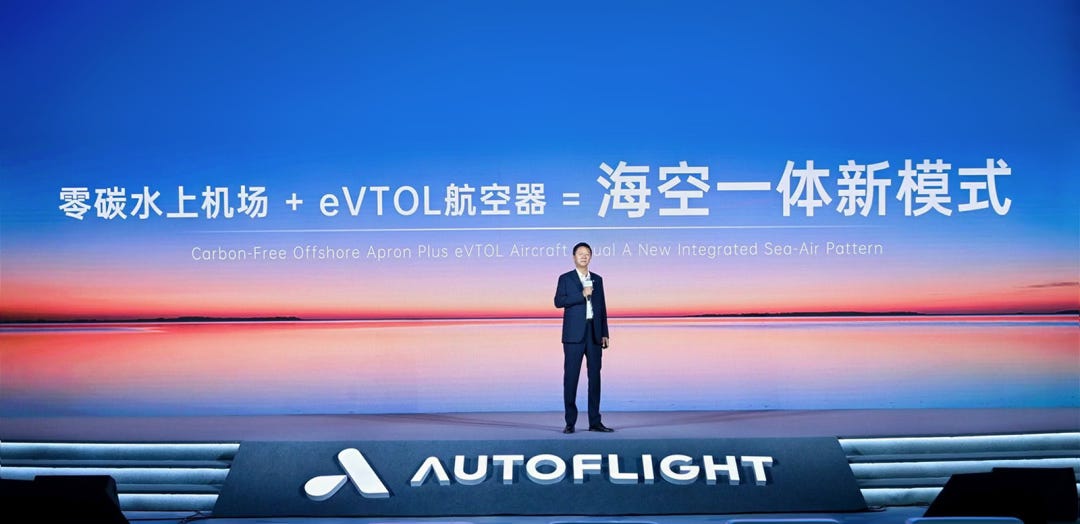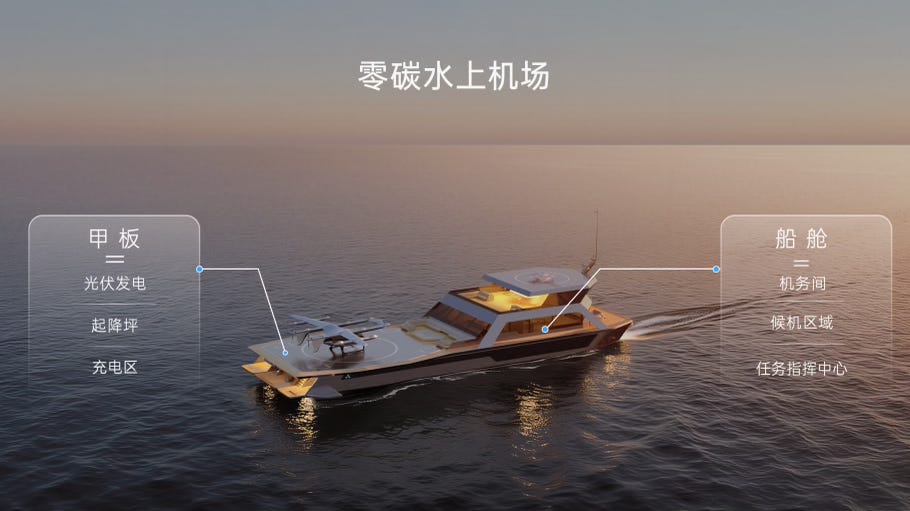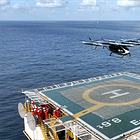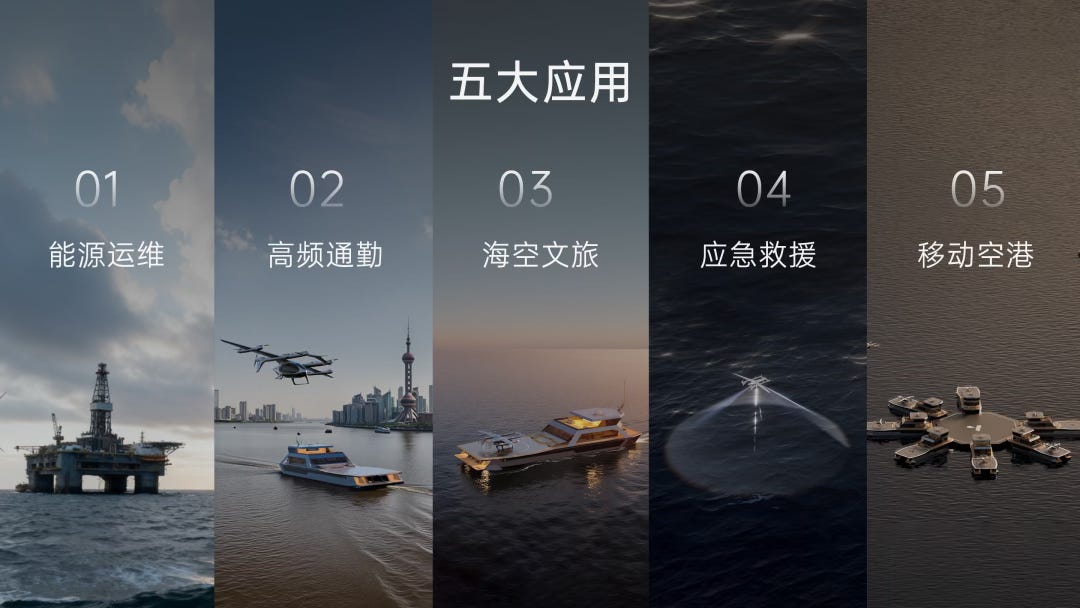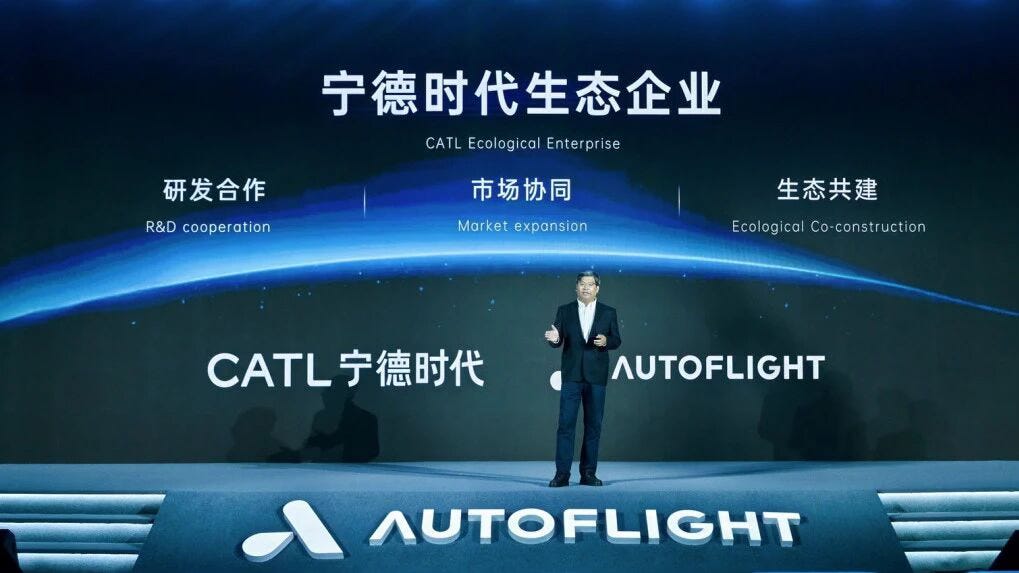AutoFlight Debuts Sea–Air Integrated eVTOL System
Water-based sites are being positioned as compatible with AutoFlight's eVTOL models.
AutoFlight announced today the release of what it describes as the world’s first “Sea-Air Integrated Low-Altitude Economy Solution,” combining a “Zero-Carbon Water Airport” with eVTOL aircraft operating as a coordinated system.
The concept extends low-altitude aviation infrastructure onto rivers, lakes, and coastal waters, aiming to address challenges such as siting constraints, long construction timelines, and complex vertiport maintenance while advancing large-scale low-altitude economic applications.
Video: AutoFlight
Designed and developed by AutoFlight, the Zero-Carbon Water Airport functions as a mobile, water-based air hub and intelligent command platform, supporting eVTOL takeoff, landing, and charging and the exchange of operational data.
The facility includes an eVTOL takeoff and landing deck, photovoltaic generation and energy-storage systems, intelligent dispatch tools, and communication support. It can be deployed rapidly across different water environments.
The Zero-Carbon Water Airport uses all-electric propulsion and incorporates a spacious deck outfitted with photovoltaic panels. Its interior serves as a passenger waiting area and maintenance space.
AutoFlight, which has strategic investment from CATL, reports that both the Zero-Carbon Water Airport and its eVTOL aircraft use CATL high-safety batteries.
The two companies are also collaborating on market development and ecosystem initiatives to accelerate the broader rollout of low-altitude economic applications.
AutoFlight notes that infrastructure for the growing low-altitude economy has not kept pace with demand, with vertiport construction cycles remaining relatively long.
Water-based sites are being positioned as compatible with the company’s principal eVTOL models — the White Shark UAV, the 2-ton-payload cargo aircraft CarryAll, and the six-seat passenger aircraft Prosperity.
Together, they form the company’s “Sea-Air Integrated” solution intended to expand point-to-point travel options, the company said.
The integrated solution is designed to support several operational scenarios.
When paired with AutoFlight’s eVTOL aircraft, it is intended to address needs in offshore energy platform operations and maintenance, high-frequency commuting, sea-air tourism, emergency rescue, and mobile airport cluster operations.
According to the company, the approach is intended to improve efficiency and support the combined development of the low-altitude and marine economies.
For offshore energy operations—such as oil platforms or wind farm maintenance—the system is described as increasing personnel and spare parts transport efficiency more than tenfold.
In emergency rescue, a combined model of UAV search and eVTOL rapid-response transport is said to reduce response time by over 50%, expand search areas, and improve personnel safety.
For high-frequency commuting, AutoFlight envisions rapid air connections within and between coastal cities, across bay areas, and between islands, reducing some travel times from hours to minutes.
One example offered is deploying a Zero-Carbon Water Airport on the Huangpu River to enable eVTOL travel between Hongqiao and Lujiazui without altering existing infrastructure.
Additional scenarios include tourism flights and the creation of distributed mobile airport clusters for higher-throughput, multi-mission operations.
As the low-altitude economy—designated as a future industry priority in China’s forthcoming “15th Five-Year Plan”—shifts from pilot projects to scaled deployment, AutoFlight positions its Sea-Air Integrated solution as a tool for leveraging water-based resources such as coastlines, rivers, and lakes.
The approach is intended to give coastal and inland waterway cities a rapidly deployable low-altitude aviation capability and to serve as a potential bridge between low-altitude and marine economic development.
AutoFlight said a public demonstration was held on November 22 at Dianshan Lake in Kunshan, where the company’s CarryAll took off from the Zero-Carbon Water Airport.
This was the first demonstration of coordinated operations between the zero-carbon airport and an eVTOL within a combined “water + low-altitude” framework.
The company also conducted a multi-aircraft formation demonstration.
Three 2-ton-class eVTOL aircraft flew in formation and carried out tasks including supply drops and life-raft deployment, illustrating potential applications in emergency response and low-altitude logistics.
AutoFlight carries out wind testing in Pingtan.


